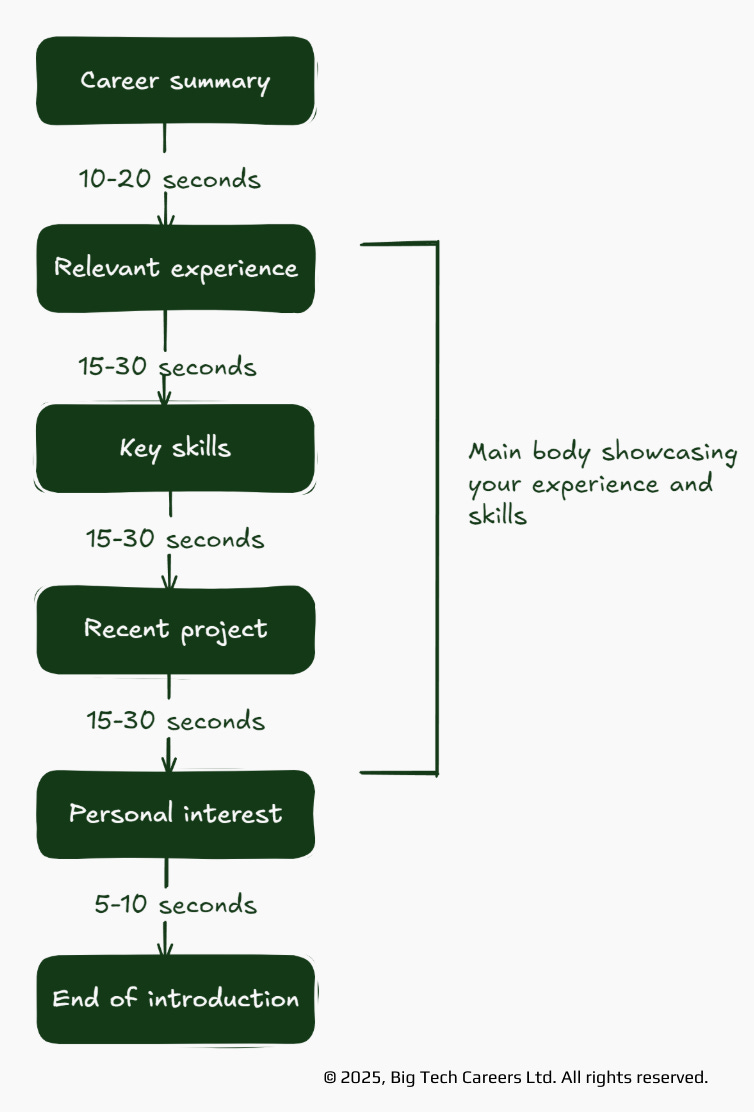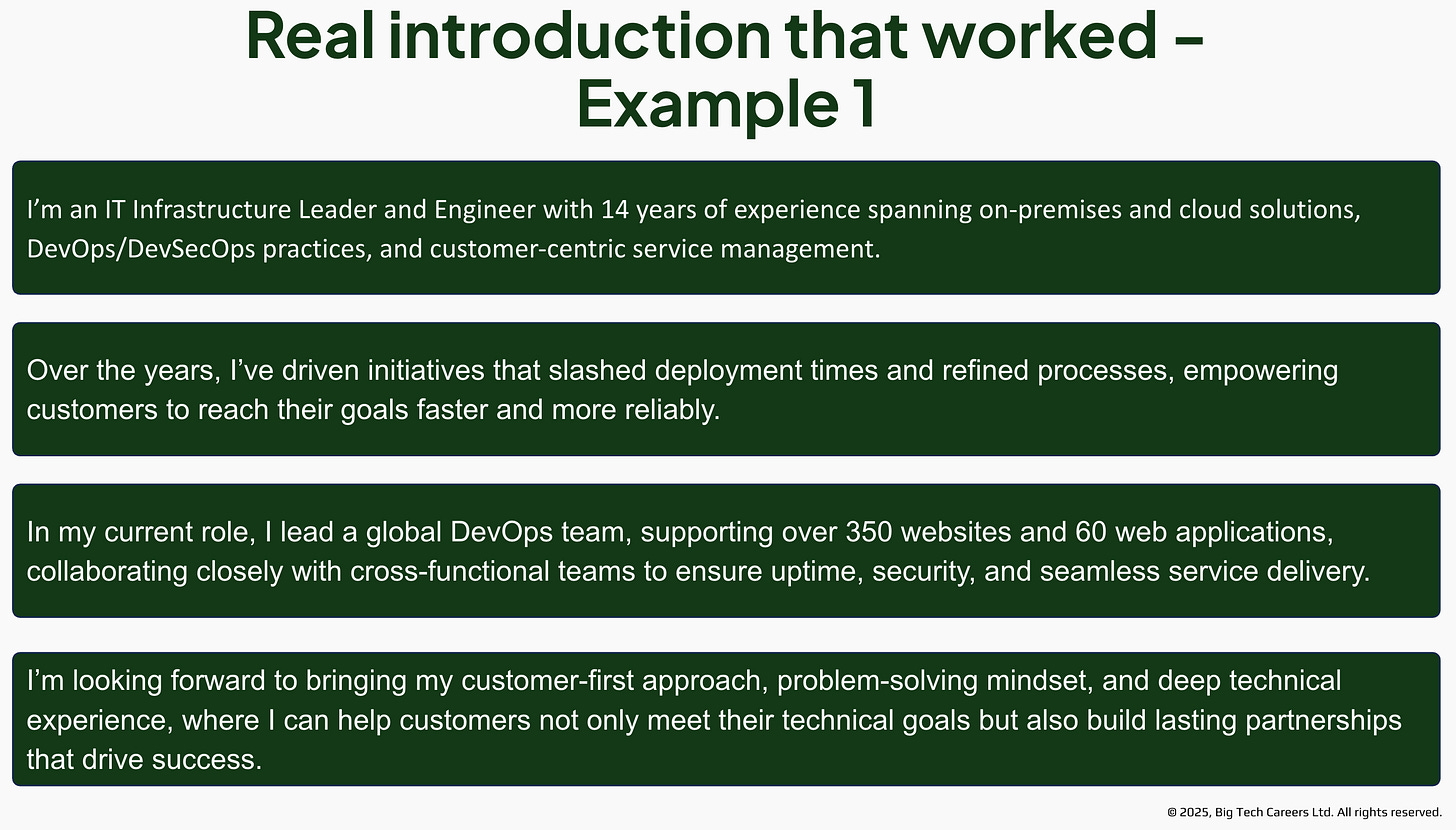The One-Minute Elevator Pitch That Will Transform Your Interview Introduction
Lessons I learned on how to introduce myself in an interview.
Hey, Prasad here 👋 I’m the voice behind the weekly newsletter “Big Tech Careers.”
In this week’s article, I share how to create an elevator pitch to introduce yourself in an interview.
If you like the article, click the ❤️ icon. That helps me know you enjoy reading my content.
I used to fail interviews because I couldn’t introduce myself effectively.
When asked “Tell me about yourself,” I’d launch into a 10-minute chronological resume recitation, watching interviewers grow visibly restless as I insisted on covering every detail of my decade-long career.
It wasn’t until later that I realized a crucial insight: when interviewers ask you to introduce yourself, they’re really asking “Tell me why I should hire you.”
This revelation changed everything. Instead of overwhelming interviewers with my life story, I learned to craft a targeted one-minute elevator pitch that highlights only the most relevant experiences for the specific role.
In this article, I’ll share the exact formula I used to transform my interview introductions, along with real examples from successful candidates who landed positions at Big Tech Companies. Whether you’re interviewing for a technical role or meeting an executive in passing, this approach will help you make a memorable first impression that opens doors.
This article is based on a lesson from the course Ace Your Big Tech Interviews with Proven Strategies, which focuses on mastering the art of behavioral storytelling and effective communication for interviews with MAANG+ companies.
Mastering Your Interview Introduction
Let’s begin by focusing on how to effectively introduce yourself in an interview. This is a crucial step in making a strong first impression.
My Early Interview Missteps
Let me share a personal story. Before interviewing with AWS, I faced numerous interview failures. Having worked at one company for nearly seven to eight years, I was out of practice with interviewing.
When asked, “Tell me about yourself,” I would launch into a detailed account of my decade-long career. I started from my graduation, discussed the companies I joined, my early experiences, and the technologies I worked with, particularly in developing a web application for a financial client. I would spend several minutes on these details. Then, I would delve into my long tenure at my current company, discussing product development and my transition to the pre-sales team. My introductions often stretched to nearly 10 minutes. Even when I noticed interviewers becoming restless, I felt compelled to share everything, believing it was necessary for them to understand my work. I even included some of my hobbies.
Reframing the Introduction Question
I eventually realized that when an interviewer asks, “Tell me about yourself,” they are essentially asking, “Tell me why I should hire you.” It’s important to tailor your response specifically to that question. Instead of a lengthy 10-minute introduction, focus on filtering out the most relevant experiences that align with the job you’re applying for. This is where the one-minute elevator pitch comes in, and we’ll focus on how everyone can create their own effective pitch.
Your Pitch Beyond the Interview Room
An elevator pitch isn’t just for interviews; it’s useful in any situation where you meet someone new. For instance, I once bumped into Adam Selipsky, the former CEO of AWS, at the London office. Because I had my elevator pitch ready, I was able to introduce myself effectively, leading to a meaningful conversation.
Often, when we encounter high-profile individuals, we might just take a selfie and move on without leaving a lasting impression. However, having a 30-second to one-minute elevator pitch prepared can help you make a memorable impact.
Building Your One-Minute Elevator Pitch
I’ve developed a formula for creating a one-minute elevator pitch that I recommend to everyone. While this is just one approach, there are multiple formats you can use, and we’ll explore several examples.
Essential Elements of a Powerful Pitch
I recommend beginning your pitch with a concise career summary, lasting no more than 10 to 20 seconds. In these initial sentences, clearly communicate your career overview.
Next, discuss your relevant experience, key skills, and recent projects, all within a maximum of one to one and a half minutes. While I refer to it as a one-minute elevator pitch, it can extend to 90 seconds or, at most, two minutes.
When discussing your experience and skills, tailor your content specifically to the role you’re applying for, the job description, and even the interviewer’s profile. You can also include personal interests or strengths to round off your introduction effectively.
My Own Elevator Pitch in Action
Here’s how I customized my introduction for a Solutions Architect role specializing in Microsoft workloads, such as .NET applications and SQL Server, with a focus on migrating and modernizing them on AWS. Although I lacked AWS experience, I emphasized my strengths in .NET applications, SQL Server, and Microsoft technologies.
I also researched the interviewer’s profile, which is often shared by recruiters or can be found on LinkedIn. Finding common ground with the interviewer can be beneficial, as it helps establish a personal connection.
For my first phone screen, I began with my career as a .NET developer, highlighting over 10 years of experience in developing and architecting applications using the Microsoft workload stack. This career summary took about 15 to 20 seconds.
Next, I discussed my current project as a tech lead, assisting UK financial institutions in digitally transforming their re-mortgage platform. I described the application, built on .NET with a WinForms frontend and SQL Server backend, and how I helped the customer by adopting agile methodologies and modernizing their monolithic application into microservices. I included keywords like “microservices” and “Jenkins CI/CD pipeline” to prompt relevant questions from the interviewer.
I also highlighted my previous experiences, focusing on my extensive work with Microsoft workloads. Since the role required pre-sales experience, I mentioned my move from India to London to join the pre-sales team, where I pitched products to financial clients.
Additionally, I noted that the interviewer was a runner, so I mentioned running the London Marathon, which sparked a brief discussion and helped build rapport.
When structuring your pitch, remember that you can’t cover everything in one minute. I usually conclude with, “I’m happy to dive deep into any of my experiences,” inviting the interviewer to explore the areas I highlighted.
Inspiring Example of a Successful Introduction
Now, let’s explore another example of successful introduction that have helped candidates make a strong impression in their interviews.
The Infrastructure Leader’s Winning Pitch
This example comes from a candidate who recently succeeded in an Big Tech interview. Their one-minute elevator pitch was instrumental in three out of four interview rounds, ultimately leading to a job offer. Here’s the introduction they used:
“I’m an IT infrastructure leader with 14 years of experience in on-prem and cloud solutions, DevOps, DevSecOps practices, and customer-centric service management.”
This concise statement effectively communicates their experience and highlights key areas of expertise, such as DevOps and DevSecOps.
They continued: “Over the years, I’ve initiated projects that reduced deployment times and refined processes, empowering customers to achieve their goals more efficiently.”
This focus on outcomes invites interviewers to inquire further about their achievements.
In their current role, they lead a global DevOps team, supporting over 350 websites and 60 web applications, while collaborating with cross-functional teams to ensure uptime, security, and seamless service delivery. This part of the introduction showcases their leadership and stakeholder management skills.
They concluded with: “I look forward to bringing my customer-first approach, problem-solving mindset, and deep technical experience, where I can help customers meet their technical goals and build lasting partnerships.”
When crafting your own introduction, consider these examples. Reflect on your background, the role you’re applying for, and your experiences to create a unique and impactful introduction.
The Big Tech interview preparation course has more examples like these to help you create your own elevator pitch.
Elevate Your Interview Introduction and Land Your Dream Role
Crafting an effective one-minute elevator pitch is a game-changer for interview success.
By reframing the “Tell me about yourself” question as “Tell me why I should hire you,” you can create a targeted, impactful introduction that resonates with interviewers.
Remember to include a concise career summary, highlight relevant experiences and skills, and tailor your pitch to the specific role.
This approach not only helps you make a strong first impression in interviews but also serves you well in unexpected networking opportunities.
If you found this approach to interview introductions helpful, there’s much more to learn about mastering the entire Big Tech interview process. The complete 3-hour Ace Your Big Tech Interviews with Proven Strategies course offers in-depth guidance on behavioral storytelling, leadership communication, and structured frameworks that can help you stand out in Big Tech interviews.
The course covers everything from delivering high-impact STAR format responses to projecting confidence through voice and body language—skills that complement the elevator pitch technique we’ve discussed here. For more details, explore the full curriculum.
Have questions? Send email at info@bigtechcareers.com
Enjoyed reading the article? You might also enjoy the most popular posts from Big Tech Careers:
Behavioral Interview Question Bank Categorized into 8 Themes
You’re Doing STAR Format Answers Wrong. Here’s How to Do It the Right Way




